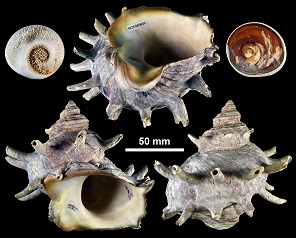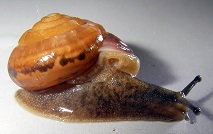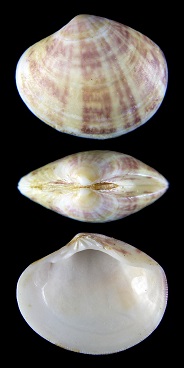Conservation of Aquatic Biodiversity
Taxonomy of molluscs and conservation of their species, populations and habitats
Staff
Research Topics
Molluscs including shellfish, snails, slugs and so on are a very diversified animal group and consist of more than 80,000 Recent species in the world, but their taxonomy and recognition of species are still poorly understood. For example, Turbo sazae is one of the most well-known marine snails in Japan since ancient age, but nevertheless the species has long been misidentified with Turbo cornutus, a species endemic to China, until recently and documented to be unnamed in 2017. Another edible species Tegula kusairo exhibited the similar case and it was described as a new species in 2020. Furthermore, many species become extinct or critically endangered by artificial environmental changes before recognizing their presences by human beings. The alpha-taxonomy of this group is thus highly important and an urgent matter in terms of biodiversity conservation.
Taxonomy and biodiversity conservation of molluscs
|
In land, freshwater, and shallow sea environments of Japan, more than 1,000 species of molluscs are endangered due to various artificial disturbances. Moreover, because many of them are quite small in size (only a few millimeters), research has been delayed. Many species are threatened without being even recognized by human beings. If nobody knows what kind of species are present and how they live, we can not save them. Our laboratory conducts basic examinations on the classification and habits of molluscs and uses them directly for conservation actions. |
 Turbo sazae Fukuda, 2017 サザエ |
Description and comparative anatomy of molluscan taxa
|
Many undescribed species of molluscs still appear in Japan. The species must be formally described and named. In addition, even in the case of already known species, classification is highly confused: multiple different species being regarded as the same species, or, being assigned to the wrong genus or family. To resolve such confusion, comparative anatomy of the reproductive, digestive, urinary, and nervous systems, etc. is effective as well as molecular examinations. Based on the information, we confirm the identity and relationships of each species. |
 Satsuma akiratadai Kameda & Fukuda, 2015 アキラマイマイ |
Collection and databasing of molluscan specimens
|
Molluscs live in most habitats on land and in water. Because they have poor migration ability, they are closely linked to the environmental conditions of the place than any other organisms, and are useful for understanding the historical transition and current status of environment. It is the best as an environmental indicator. We are collecting molluscs from all over Japan, preparing specimens, and making a database. As of May 2022, about 30,000 lots of specimens have been registered. |
 Sunetta beni Fukuda, Ishida, Watanabe, Yoshimatsu & Haga, 2021 ベニワスレ |
Publication List
- Fukuda, H., Ishikawa, H., Ito, S. & Haga, T., 2022. Nitidotellina hachiensis n.sp. (Bivalvia: Tellinidae) from the Seto Inland Sea, between Honshū and Shikoku, western Japan. Molluscan Research, 42: in press.
- Fukuda, H., Ishida, S., Watanabe, T., Yoshimatsu, S. & Haga, T., 2021. The bivalve genus Sunetta (Heterodonta: Veneridae) of Japan and the neighboring waters – a taxonomic revision with the descriptions of three new species. Molluscan Research, 41: 107–171.
- Yamazaki, D., Hirano, T., Chiba, S. & Fukuda, H., 2020. A new replacement name for Chlorostoma lischkei Pilsbry, 1889 (not of Tapparone-Canefri, 1874) (Vetigastropoda: Trochida: Tegulidae). Molluscan Research, 40: 327–344. https://doi.org/10.1080/13235818.2020.1831716
- Saito, T., Chiba, S. & Fukuda, H. 2020. Type materials of the species of the Planorbidae (Mollusca, Gastropoda, Hygrophila) described by Shuichi Mori. Molluscan Research, 40: 169–182. https://doi.org/10.1080/13235818.2020.1724604
- Fukuda, H., 2019. Assimineidae H. & A. Adams, 1856. In: Lydeard, C. & Cummings, K.S. (eds), Freshwater Mollusks of the World. A Distribution Atlas, pp. 94–100. Johns Hopkins University Press, Baltimore.
- Saito, T., Do, V.T., Prozorova, L., Hirano, T., Fukuda, H. & Chiba, S. 2018. Endangered freshwater limpets in Japan are actually alien invasive species. Conservation Genetics, 19: 947–958. https://doi.org/10.1007/s10592-018-1068-5
- Fukuda, H., 2017. Nomenclature of the horned turbans previously known as Turbo cornutus [Lightfoot], 1786 and Turbo chinensis Ozawa and Tomida, 1995 (Vetigastropoda: Trochoidea: Turbinidae) from China, Japan and Korea. Molluscan Research, 37: 268–281. https://doi.org/10.1080/13235818.2017.1314741